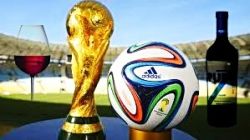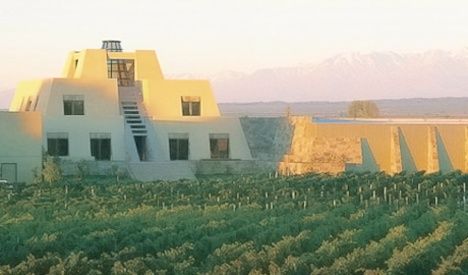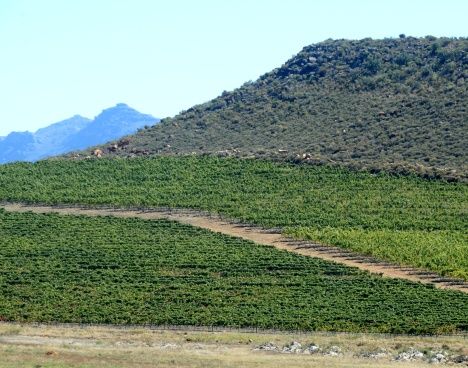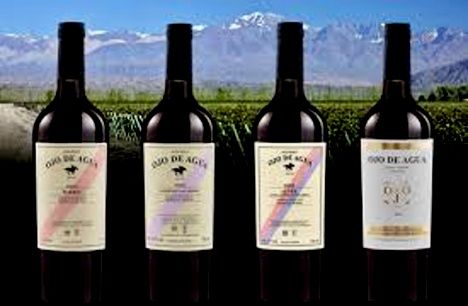They didn't make it at the World Cup, only runners-up, only silver. What does that matter, when all that counts is gold? Argentina deadly sad, Germany sky-high jubilant. That's sport. For me - as a moderate to rare sports consumer - the world of sports emotions has another level, a predominant level. Because I drink a good glass of wine with every game - otherwise I usually fall asleep - I try to find suitable wines, usually something from the country of the players acting at the moment. That used to be easy: France, Italy, Spain, Portugal... But at this World Cup they dropped out early. So I was left with Riesling and Argentinian wines for the final.

|
| Football and wine (Photo: P. Züllig) |
The area under vines is said to be around 200,000 hectares, producing almost 15 million hectolitres of wine a year. Of course fair wines, I thought, because the Spaniards brought wine to South America, first of all to be able to celebrate the fair (also after the fair, for that they needed wine for the masses). But that was all in the past: today there is a wine culture in Argentina, beyond the mass wines. I remember a visit by Laura Cantena - the winemaker from the Bodega Catena Zapata - in Zurich. But above all, I remember her wines, especially the Malbec.

|
| Bodega Cantena Zapata (Photo: P. Züllig) |
It's a good thing that I couldn't find this wine, especially the "Cantena Alta" from vines that grow at an altitude of between 900 and 1,500 metres, here - in the middle of the Languedoc. I suspect the World Cup final would have lasted much, much longer for me; maybe it still wouldn't be over. Only one thing would be certain: for me, there would probably have been another winner - the Malbec from Argentina.
When I think about it - unfortunately without the corresponding wine in the glass - wines that until recently were described as experiments, namely wines from high altitudes, have gained incredible prestige. First it was Heida wine (Païen aka Traminer), from the "highest vineyard in Europe" in Valais. Then my patriotic disappointment that there should be an even higher quality vineyard in the Pyrenees. Then recently I visited - also at a good 1,000 metres above sea level - the Cederberg vineyard in South Africa with its excellent wines. And now, in memory, a Malbec, from Mendoza, from the Argentinian mountains (up to 1,500 metres above sea level). In all these wines, which are so different (Heida is a white), power, concentration, elegance and depth dominate, and they all have a wonderful finish.

|
| Cederberg% South Africa: vines at more than 1,000 metres above sea level (Photo: P. Züllig) |
For me, "the turning point" in Argentine wine culture came years ago, purely by chance. A good acquaintance was travelling through Argentina and ended up at a winery and with Argentine wines that made a mighty impression on her. Anyway, she began to talk about the "Argentine miracle" and would like to lure me - the wine lover - to Argentina again and again. Until then, and until I got to know the wines of Bodega Catena Zapata, the Argentines (the wines, of course) were rather comparable to the former Algerians: simple, light, bright and lacking in flavour, at best table wines, for local consumption and of no significance for Europe (at most as cheap wines for blending).

|
| Puro wines by Dieter Meier from Argentina (Photo: P. Züllig) |
It is no coincidence that every Swiss wine lover associates the name Dieter Meier with Argentina, the Swiss conceptual artist, musician ("Yello"), filmmaker, businessman and jack of all trades. Years ago, he had vines planted on a huge organic farm in Mendoza and produced the three organic wines of the "Puro" line: a pure Malbec and two blends, one of Malbec, Cabernet Sauvignon and Merlot ("Corte"), the other of Malbec, Cabernet Franc and Cabernet Sauvignon ("Corte d'Oro"). Price: 17 to 30 francs. Of course, Argentinean viticulture is not exhausted with these few wines, but their distribution in Europe is still small. I admit, without this World Cup and my somewhat offbeat approach of drinking the "right" wines with the games, this time brought me (almost world champion-like) to South America. With Germany - they say: the deserved winner - I could have made it easier for myself. A German Riesling would probably have been easier to find here - on the Mediterranean coast. But with Argentina - or even (as expected) Brazil - I was faced with almost insoluble problems. At the next World Cup - should it be other nations, such as Ethiopia, Mozambique or even East Timor - I would have to pass on my world-champion wine tradition for good. It's a pity, because hardly ever have I learned so much about little-known wines in sport as I did in this round. Thank Argentina, even if it is only silver.
Yours sincerely